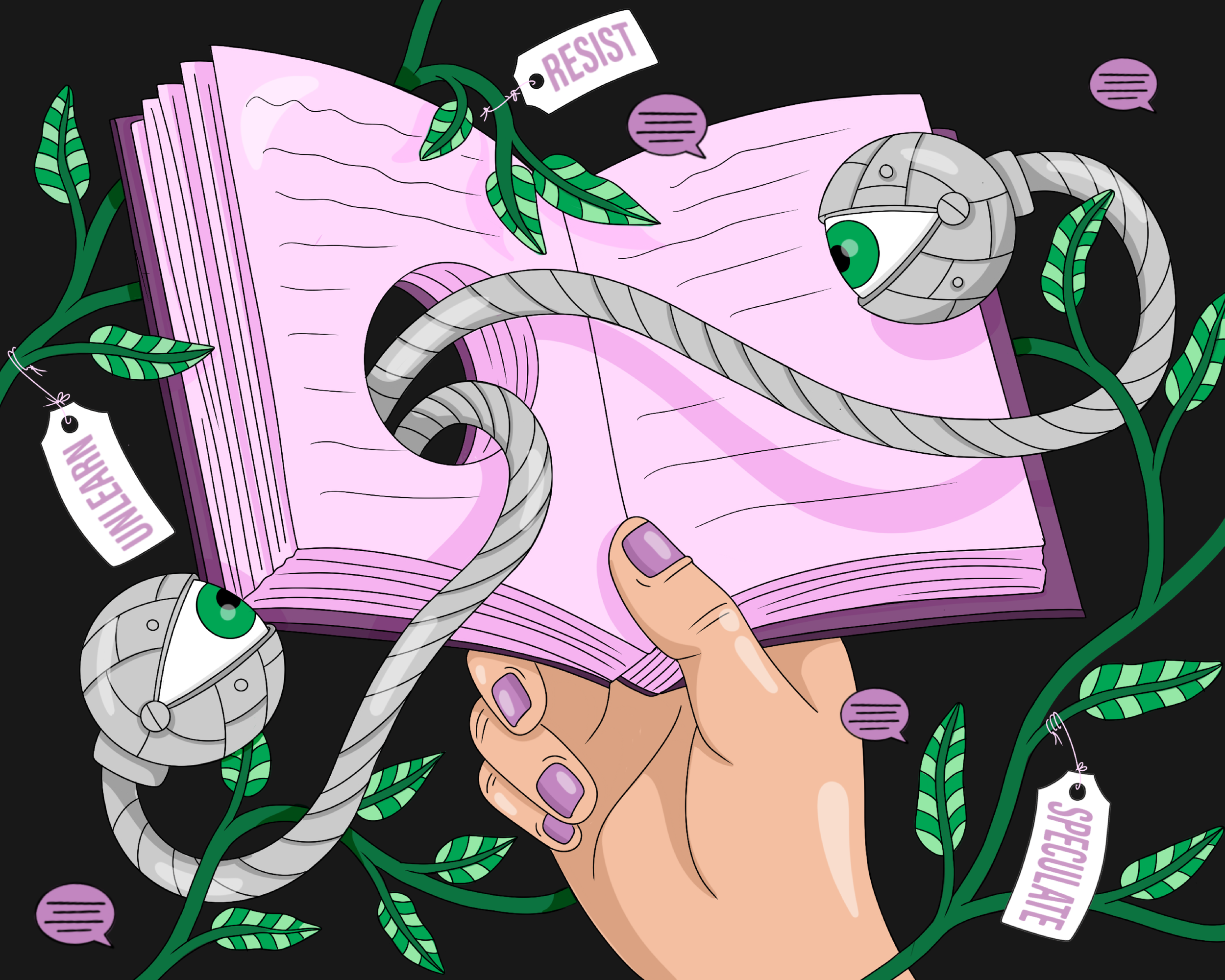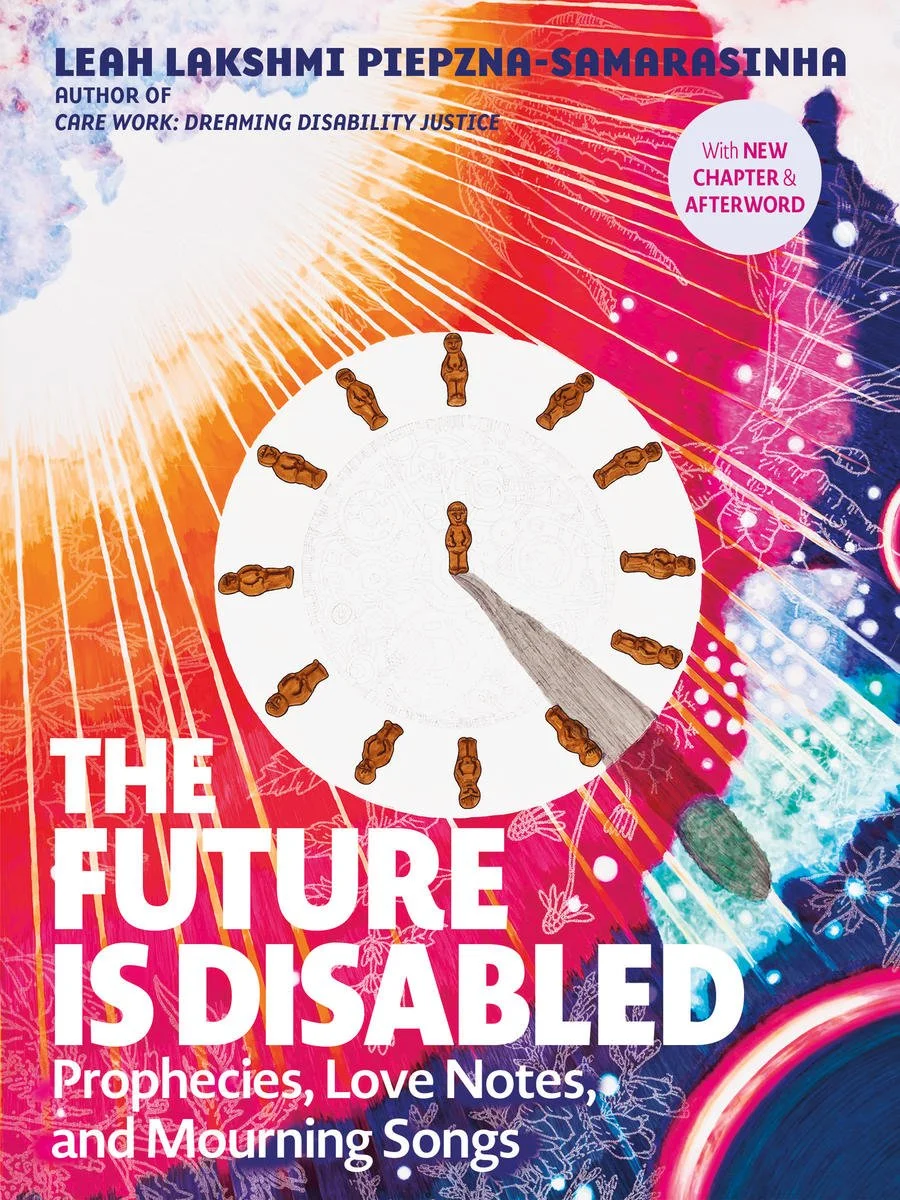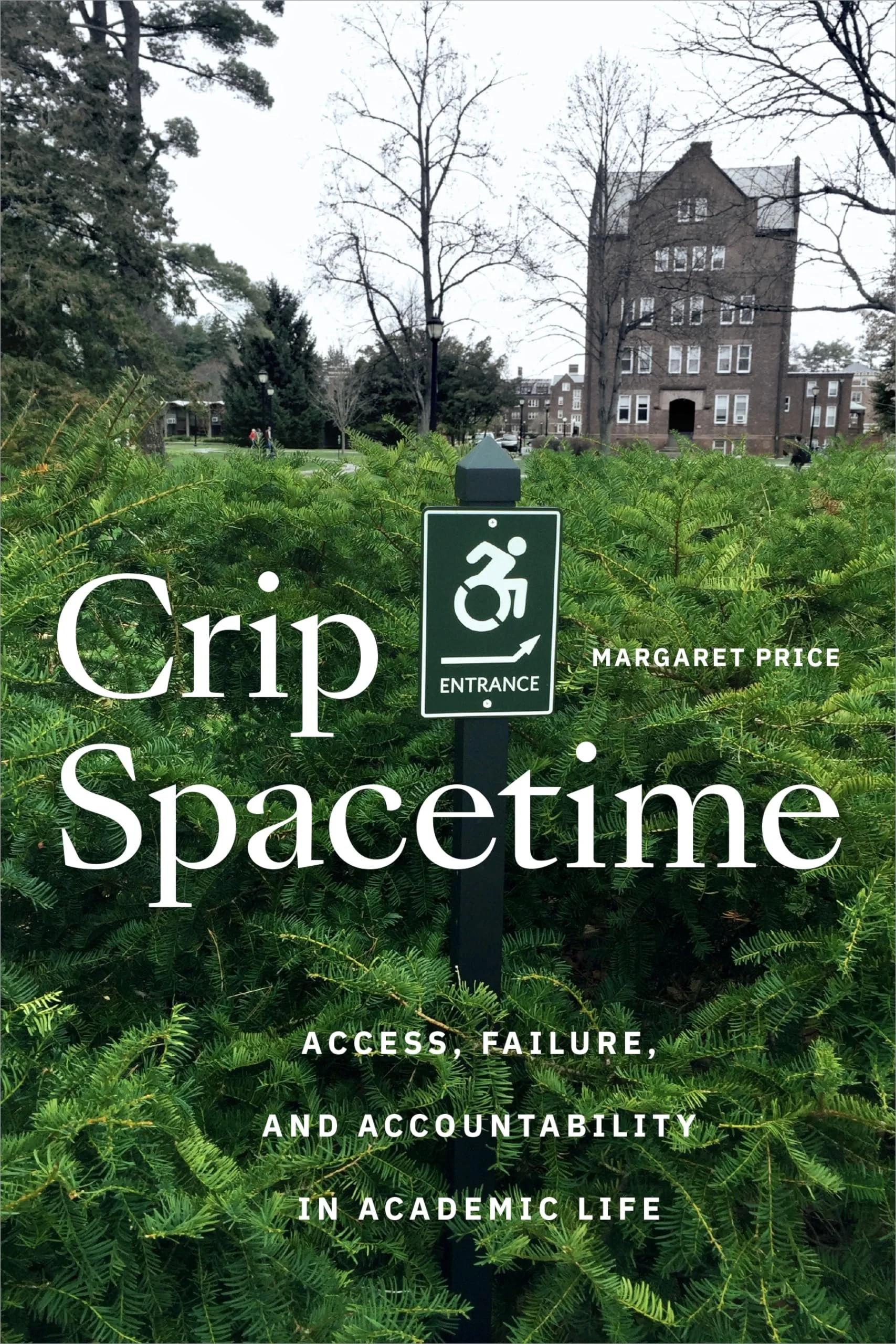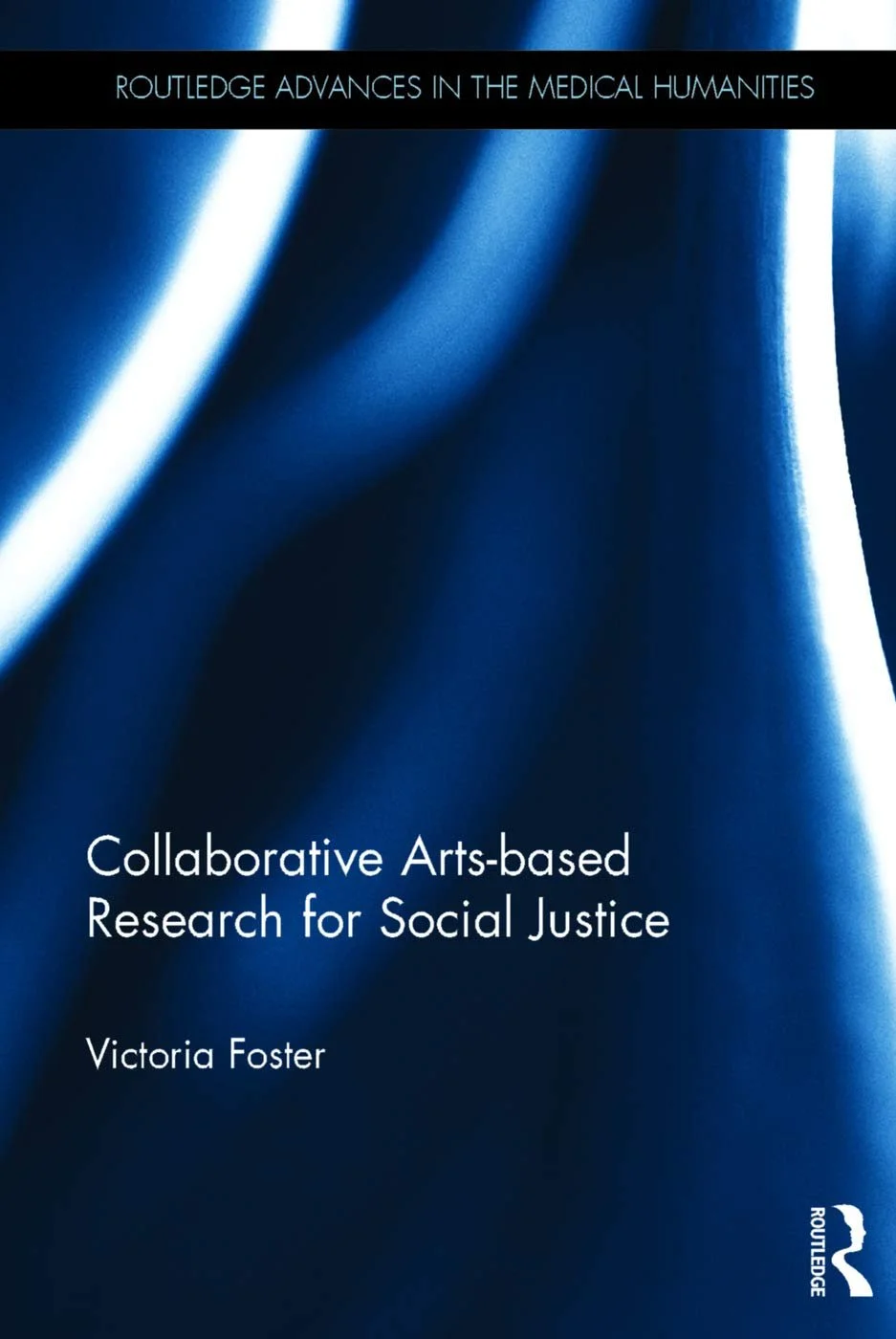Reading/Weaving Disability Futures: A Bibliographic Tour of Our Project
illustration by Lynne Zakhour
Nothing happens in a vacuum, and this is certainly true of academic work. The beauty of research is that we weave our ideas into a centuries-old tapestry of knowledge and ideas stretching into infinity. The less beautiful part is the often unfair and unbalanced way people are recognised for their contributions to this tapestry. Who gets to have their name sewn into the tapestry (how big? how centrally placed?) and who has to do the (maybe thankless, maybe burnout-inducing) labour of weaving? Even in justice-oriented disciplines, we are often encouraged to cite the same small collection of mostly white Western men, as feminist scholars like Sara Ahmed and the team at CLEAR Labs have recently highlighted. This renders the work of many marginalised people invisible and allows scholars to stand at the top of an invisible hill, appearing to levitate.
In this inaugural blog post of the Doing Disability Futures project, we want to begin by making it clear that we do not claim to be the first ones to do any of this. Academia has a tendency to encourage a colonial mindset where we strive to plant our flag in the knowledge landscape, claiming ideas for our own. We do not want to reproduce such a mindset. It is important to recognise how and where ideas come to be, and whose (rarely singular, often collaborative) labours produced them. At the Centre for Women’s Studies, University of York, where I did my PhD, I was always told: we are not aiming to reinvent the wheel but to put another brick in the wall that has been growing and supporting us all for decades, so we can help future scholars grow and feel supported in the future. With this project we are of course striving to find new ways of doing disability and futures, to think differently, together – but this is by no means work we are doing from scratch. It is only made possible by those who have done this work before us and who continue to do it alongside and intertwined with us.
Our first blog post is, in a way, an annotated bibliography of texts that have inspired Doing Disability Futures – but in the spirit of always attending to methods and practices, to the “doing”, highlighting the intertwining of ideas and the living vitality of disability theory as oriented towards praxis (as discussed by Nirmala Erevelles), this is not a static list of texts and theories. In what follows below we (or rather I, Francesca Lewis, speaking as myself and as a member of the collective) weave some of the key texts that have animated our work so far into a bibliographic tour of Doing Disability Futures.
“At the core of my work and life is the belief that disabled wisdom is the key to our survival and expansion. Crip genius is what will keep us all alive and bring us home to the just and survivable future we all need. If we have a chance in hell of getting there.” (p. 17)
We began this project by thinking a lot about access and crip care. We wanted to create accessible and welcoming spaces for ourselves and our collaborators, and we wanted to think about how this work itself could really prioritise the access needs of everyone involved in a sustained and sustainable way. Piepzna-Samarasinha’s work (along with Eli Clare’s - see the last entry on this list) was particularly instrumental in shaping our thinking from its beginnings. They centre the importance of crip care, of disabled community, and in The Future is Disabled unapologetically imagine, desire, and argue for a world where disabled people are not only “tentatively allowed to exist” , but “accepted without question as part of a vast spectrum of human and animal ways of existing”, filled with valuable knowledge, strategies, and survival skills. The COVID-19 pandemic has radically reshaped how people think about disability on a global scale – as Piepzna-Samarasinha puts it, “the world has been cripped”. (Piepzna-Samarasinha, p. 22, 23) It becomes increasingly impossible for disability to be framed as the exception, as a rare thing most people don’t need to think about. This is a text that spins together dreams, reflections, and practical proposals for living with grief, surviving through community-building, thinking through access, and expanding mutual aid with disabled wisdom.
Arts-based Disability Justice
“Perhaps the most compelling survival tool that disabled, queer, gender non-conforming, and transgender communities of color have is their dreamwork. Dreaming is not passive. In dreaming, our communities materialize a world where, through fury and love, transformation in all its rebelliousness thrives.” (p.15)
Within DDF, we are collaborating with disabled artists and marginalised communities to explore how speculative and arts-based methods can address histories of colonial violence and ongoing injustices while storytelling alternative futures, disrupting existing knowledges, and challenging power hierarchies. This makes the Disability Justice principles of Sins Invalid important touchstones for our work. They centre “disabled, queer, trans, and gender-nonconforming bodyminds of colour”, exploring liberatory ways of living and knowing, and taking art seriously as a tool for survival. In Crip Kinship, Shayda Kafai gives a loving account of the transformative work of Sins Invalid and the history of their movement and ideas. The San Francisco Bay Area-based performance project takes an embodied approach to radically imagine what working through and with our bodyminds can do for queer crip liberation. Sins Invalid has had a huge impact on the queer crip landscape, and their influence continues to grow as many disabled scholars and activists seek to enact disability justice principles in our work and lives. After aptly opening the book’s introduction by drawing a tarot card from Cristy C Road’s The Next World Tarot, a deck infused with social justice, crip care, and the art of imagining otherwise, Kafai highlights the importance of dreamwork as a tool of survival, vital to our dreaming of a future that isn’t just liveable for some but irresistible for all. (something of a project motto, coined by Dr Kylo Thomas)
Doing Academia Otherwise
“Inhabiting crip spacetime goes beyond simply having a different point of view or different lived experience. Experiencing the material differences of life as part of a subaltern group—including the joys, the surprises, and the harms—constitutes a different reality (Escobar 2017).” (p. 8)
The title of our project, “Doing” Disability Futures, emphasises methods and methodologies, signalling that we are interested in the “how” of it all. How do we do the workshops, the collaborative work, the writing, even the admin, differently, the way we and our scholar/activist ancestors and peers have dreamed? Academia is not exactly a space where disability justice just happens – in fact, you could say that much of what academia inherently is takes a somewhat (or even explicit!) ableist form. Like many justice-oriented disciplines, Disability Studies can certainly be accused of considering itself the exception to this. Often, we look outside the realms of academia and our own hallowed halls to call out oppressions, while leaving those close to home, that actually impact our own scholars and students, unexamined. In her long-anticipated follow-up to 2011’s Mad at School: Rhetorics of Mental Disability and Academic Life, Margaret Price returns to the question of disabled academics with Crip Spacetime. Here the focus is academic productivity culture and its impact on disabled academics. Price critiques the prevailing approach of granting individual accommodations to academics, and argues that disabled academics have a unique experience of time, space, and reality, occupying what she calls “crip spacetime”. With its call for collective rather than individualised approaches to disability, Price’s book shows us something that comes up again and again in the works on this list, and many others in our extended bibliography: that disabled people are experts in worlding. Many, though not all, members of our team of academics, artists, and/or activists are disabled – and we are working together to do academia otherwise.
Collaborative and Creative Research
“I have chosen to use the term ‘collaborative’ in the book’s title rather than ‘participatory’ because this is a more encompassing concept. This way of working is not solely about the participation of the researched in the process of knowledge production; it is about teaming up with artists, poets and performers; making links between the academy and communities; and crucially, engaging with audiences. This choice of terminology does not, however, avoid the substantial critique that has been levelled at participative approaches.” (p.11)
Doing Disability Futures is a project that aims to reach beyond academia, both in the production and dissemination of knowledges. Phase 1 of our work has been peer-led research with marginalized LGBTQ+ communities, drawing on arts-based methods for disability justice. This collaboration, led by Dr Ingrid Young (University of Edinburgh) and Dr Kylo Thomas (The Love Tank) presented insights, complexities, and many felt and embodied collective experiences that we will spend the rest of this project attempting to parse out and learn from. Part of this will be working with project artist Lynne Zakhour and workshop participants to create an exhibition of artwork created in the workshops as well as a series of illustrations that respond to the emerging themes. In Collaborative Arts-based Research for Social Justice, Foster centres the ethics of social justice-oriented research, while simultaneously giving an overview of key aspects of the arts-based collaborative approach and critically interrogating its underlying assumptions and potential impact within academia and on the bodies of collaborators. She questions taken for granted notions within this kind of research, such as ideas presuming total authenticity in lived experience work and assuming we are ‘giving a voice’ by collaborating with marginalised groups. She also draws attention to the politics of emotional and embodied knowledges, which may challenge binaries and dualisms but may also be a means to exploit communities marked out as ‘different’ via a voyeuristic gaze. As this project unfolds, these are questions we will continue to reflect on and hold ourselves accountable to.
Crip Histories and Lineages
“While we continue to be moved by the frictions and reverberations between [‘crip’ and ‘queer’], we also want to reaffirm the work of scholars and activists who have, both independently and collectively, worked to chart alternate genealogies for crip, not (only) via (white) queerness but through critical theories of race, ethnicity, and indigeneity, as well as Black feminism, Black music, and queer of color critique.” (p.7)
The Doing Disability Futures project may look ahead towards new transformative possibilities for - and through the imaginative knowledges of - disabled folks, but it does so with attention to how we got here: the colonial histories and eugenic legacies that built and continue to influence the current world, and the resistance of these forces by those they seek to control, exploit, and eradicate. With an introduction by Therí Alyce Pickens, and from an editing team comprised of key voices in Disability Studies Mel Y. Chen, Alison Kafer, Eunjung Kim, and Julie Avril Minich, this collection brings the scholarship and activism of transnational queer, trans feminists of colour into the spotlight. In the name of cripping Disability Studies, a discipline that often reproduces white Western logics of singularity, linearity, and normality, this volume takes an explicitly intersectional anti-racist and anti-ableist approach. As the title suggests, many of the essays featured in Crip Genealogies ask how we might learn from our queer crip ancestors, elders, and peers, how we can honour our histories and lineages in their multiplicity, in their mess, in the theories and practices that point us towards justice. We also very much appreciate the final chapter of the book, “Afterwords”, in which the four editors share short pieces based on the following prompt, encouraging readers to try it too – we will, why don’t you!
Write 800 words on a word, concept, text, image, framework, experience, sound, sensation, movement, intervention, collective, figure, elder, imaginary, movement, tradition, or worlding that is key to your understanding and practice of disability studies. We are most interested in items (or persons) that are idiosyncratic to your own orientations and solidarities; what constitutes your disability studies (ds) (or its archive or crip genealogy) and why? (p. 319)
Theorising the Speculative
“Speculative fiction allows us to imagine otherwise, to envision an alternative world or future in which what exists now has changed or disappeared and what does not exist now, like the ability to live on the moon or interact with the gods, is suddenly real. For marginalized people, this can mean imagining a future or alternative space away from oppression or in which relations between currently empowered and disempowered groups are altered or improved. Speculative fiction can also be a space to imagine the worst, to think about what could be if current inequalities and injustices are allowed to continue.” (p.2)
As a project interested in futures, imagination, and how we might think differently through arts and fiction, Doing Disability Futures has a huge investment in the speculative. Phase 2 of the project, led by Dr Donna McCormack (University of Strathclyde) is undertaken in collaboration with our partners Professor Lisa Käll (Stockholm University) and Dr Ingvil Hellstrand (University of Stavanger) and focuses on speculative fiction. In particular, the project is interested in how looking at the overlapping topics of colonialism in the Caribbean and eugenics in the Nordic countries via speculative fiction can help us see the intertwined histories and legacies of these contexts, as well as their specificities and particularities. Schalk’s Bodyminds Reimagined brings together Disability Studies and Critical Race Theory in the first monograph about Black authors’ representation of disability. Foregrounding both the bodymind, as the anti-dualist approach to embodiment, and (dis)ability, as an encompassing term that highlights “the overarching social system of bodily and mental norms that includes ability and disability”, Schalk proposes that we see Black women’s speculative fiction not only as material to study these concepts within, but as productive of their own knowledges and concepts. (Schalk, p.6) These are texts alive with theory, and through them Schalk invites us to question the ideologies that underpin terms like (dis)ability, race and gender.
Theorising Ongoing Violence, Colonialism, and Eugenics
“This deployment of the term “capacity” is an amendment to affect studies, which posits affect as endless capacitation of the individuated body, even as it might always see that body as relational. In reading affect through and with populations along with bodies, dividuals beside individuals, and societies of control working through forms of discipline, I want to provide a necessary corrective to studies of affect that take the integrity of the human form for granted.” (p. 1-2)
The kind of worlding that this project is involved in is as much made of histories (their harms, their lessons) and present pressing questions for survival as of unreal sci-fi visions. Our current moment and recent history – from the climate crisis to the COVID-19 pandemic to ongoing genocide in Gaza – creates the conditions for radical action, reimaginings of care, and an urgent need to think differently about bodies, their capacities and their value. Puar’s The Right to Maim faces these questions head-on, bringing the justice-oriented concerns of Critical Race Theory and Disability Studies into conversation with Affect Theory and New Materialisms. She asks those invested in disability to consider the concepts of debility and capacity, in order to “rethink disability through, against, and across the disabled/non- disabled binary.” (Puar, p. 2) Taking particular interest in technology and its mobilisation in neoliberal systems that facilitate slow death that may not be legible as disability, Puar analyses Israel’s policies and its “mass debilitation of Palestinian bodies”. She also asks those who work with affect theory, who often draw on Spinozan notions of the body’s capacity to affect and be affected, to remember that Deleuzian ideas like the body without organs and the assemblage describe not only individuals but help us think more carefully about affect on the level of politics, as population.
“[Y]ou the reader are encouraged to explore the edges of your own imagination— the border patrols others have imposed, as well as the monitoring systems you may have installed yourself, including those gatekeepers squatting in the nooks and crannies of your thinking, forcing you down certain pathways and telling you to avoid others. How can we expect to change social structures when we continue to nurture the same habits of mind in our mental structures?” (p.11)
Futures and technologies have long been intertwined. Within utopian visions of flying cars often lies a colonial and eugenicist logic of progress. Yet technology also has such power and promise for marginalised folks, as demonstrated by BLM’s use of cameras and social media, by queer and trans communities’ use of gender-affirming meds, and by ways that sexual health and contraceptive innovations continue to mediate and in some ways ‘liberate’ our access to love and pleasure. Captivating Technology helps us think through the tension between the harm technoscience does and its liberatory potential. The volume was edited by Ruha Benjamin, whose own work focuses on the intersections of race, technology, and science, and on the tension between equity and innovation. One of the key insights to be found here is that we need to think beyond individual intent. It is not a matter of whether an algorithm was programmed to be racist, but rather of how “technoscience reflects and reproduces social hierarchies, whether wittingly or not.” (Benjamin, 2019, p. 2) The essays contained here take us on a tour of carceral technologies, from the traditional (plantations, prisons) to the more hidden systems of surveillance (Facebook, fast fashion) and offer a continuum of alternatives, a blueprint for decarceration from abolitionists to Afrofuturists. This is a volume that beautifully models how to theorise futures, holding its utopian and dystopian potentials in mind simultaneously, and never forgetting our own investments and complicities.
Storytelling as Resistance (and “staying with the trouble”)
“I couldn’t tell any one story without being interrupted by a half dozen others. I landed inside a knot of contradictions. Cure saves lives; cure manipulates lives; cure prioritizes some lives over others; cure makes profits; cure justifies violence; cure promises resolution to body- mind loss. I grappled through this tangle, picking up the same conundrums and questions repeatedly, turning them over and over, placing them side by side, creating patterns and dialogues.” (p.xvi)
The DDF Team is a creative bunch. Some of us make visual art, some are poets, and some aspire to think creatively, expansively. Imagining otherwise is of course a key principle in the project, and as I have discussed above this means imagining how we do this work differently as much as what we say/analyse/propose. We are doing collaborative arts-based work, producing an exhibition and a podcast, talking to artists and writers. One of the outputs we aim to publish is an anthology recording all of that creative and collaborative practice, imagined as something that pushes beyond the usual boundaries of an academic anthology. It is not only Clare’s way of writing that we love, of course, with its creative/critical weaving of a patchwork of fragments, but the richness of his honest and incisive provocations – “storytelling as resistance”, as Alice Wong described it. This is a text that resists simplistic binaries and sits with uncomfortable knots that may not be untangleable. Clare explores what medicine does, what medical language, medicalisation, medical treatments do to and for us, and how we can live in the unresolved and unreconciled space this puts marginalised folks in. There are no easy answers here – Clare wouldn’t want any, nor would we. Instead, there is a commitment to, as Donna Haraway would put it, “staying with the trouble”, to sitting with difficult questions and tensions, taking the time to see how the knots got tied, practicing untangling them together.
Finally, I leave you with this video of disabled artist Raisa Kabir’s collective socially distanced weaving performance, House Made of Tin. Created in October 2020, by, for, and from BIPOC, disabled, and queer participants, the performance embodies much of what was discussed above. As Kabir describes it, “The visible face masks and physical distance between participants underscores the urgency and precarious nature of support structures during a time of pandemic. By embodying these structures of support and mutual aid, this performance asks us to consider how labor and care are connected across all bodies and borders.”









